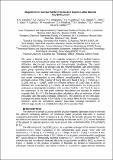Files in this item
Thermodynamic properties, electron spin resonance and underlying spin model in Cu3Y(SeO3)2O2Cl
Item metadata
| dc.contributor.author | Zakharov, K. V. | |
| dc.contributor.author | Zvereva, E. A. | |
| dc.contributor.author | Berdonosov, P. S. | |
| dc.contributor.author | Kuznetsova, E. S. | |
| dc.contributor.author | Dolgikh, V. A. | |
| dc.contributor.author | Clark, Lucy Mary | |
| dc.contributor.author | Black, Cameron | |
| dc.contributor.author | Lightfoot, Philip | |
| dc.contributor.author | Kockelmann, W. | |
| dc.contributor.author | Pchelkina, Z. V. | |
| dc.contributor.author | Streltsov, S. V. | |
| dc.contributor.author | Volkova, O. S. | |
| dc.contributor.author | Vasiliev, A. N. | |
| dc.date.accessioned | 2014-12-11T17:31:02Z | |
| dc.date.available | 2014-12-11T17:31:02Z | |
| dc.date.issued | 2014-12-05 | |
| dc.identifier | 159509800 | |
| dc.identifier | cdfe65c0-85a7-4471-b1a3-626ebb3704c5 | |
| dc.identifier | 000346606100003 | |
| dc.identifier | 84916202899 | |
| dc.identifier.citation | Zakharov , K V , Zvereva , E A , Berdonosov , P S , Kuznetsova , E S , Dolgikh , V A , Clark , L M , Black , C , Lightfoot , P , Kockelmann , W , Pchelkina , Z V , Streltsov , S V , Volkova , O S & Vasiliev , A N 2014 , ' Thermodynamic properties, electron spin resonance and underlying spin model in Cu 3 Y(SeO 3 ) 2 O 2 Cl ' , Physical Review. B, Condensed matter and materials physics , vol. 90 , 214417 . https://doi.org/10.1103/PhysRevB.90.214417 | en |
| dc.identifier.issn | 1098-0121 | |
| dc.identifier.other | ORCID: /0000-0001-7048-3982/work/59464460 | |
| dc.identifier.uri | https://hdl.handle.net/10023/5917 | |
| dc.description | The collaboration between the University of St Andrews and Moscow State University was funded by a Royal Society International Exchanges grant, in collaboration with the RFBR (12-03-92604). P.L. and L.C. also thank the Leverhulme Trust (Award RPG-2013-343). | en |
| dc.description.abstract | We report a detailed study of the magnetic properties of the buckled kagome compound Cu3Y(SeO3)2O2Cl using heat capacity, magnetization, powder neutron diffraction, electron spin resonance and first-principles calculations. The crystal structure is confirmed to be isotypic with the mineral francisite, with orthorhombic space group symmetry Pmmn throughout the temperature range 5 – 300 K. Magnetization, heat capacity and neutron diffraction confirm long range magnetic order below TN = 35 K. The electron spin resonance spectra reveal the presence of two modes corresponding to two different crystallographic Cu positions. The principal g-values of the g-tensor of Cu(1) sites were found to be g1 = 2.18(4), g2 = 2.10(6) and g3 = 2.05(9), while the effective g-factor of Cu(2) sites is almost isotropic and is on average g = 2.09(5). At low temperatures, Cu3Y(SeO3)2O2Cl undergoes a metamagnetic transition, with a critical field BC = 2.6 T at 2 K, due to the suppression of the inter-plane exchange interactions and saturates in modest magnetic field, BS ≤8 T. The first-principles calculations allow an estimation of both intra-plane and inter-plane exchange interactions. The weakness of the inter-plane exchange interaction results in low values of the critical fields for the metamagnetic transition, while the competition between intra-plane exchange interactions of different signs results in a similarly low value of the saturation field. | |
| dc.format.extent | 1311172 | |
| dc.language.iso | eng | |
| dc.relation.ispartof | Physical Review. B, Condensed matter and materials physics | en |
| dc.subject | QD Chemistry | en |
| dc.subject.lcc | QD | en |
| dc.title | Thermodynamic properties, electron spin resonance and underlying spin model in Cu3Y(SeO3)2O2Cl | en |
| dc.type | Journal article | en |
| dc.contributor.sponsor | The Royal Society | en |
| dc.contributor.sponsor | The Leverhulme Trust | en |
| dc.contributor.institution | University of St Andrews. School of Chemistry | en |
| dc.contributor.institution | University of St Andrews. EaSTCHEM | en |
| dc.identifier.doi | https://doi.org/10.1103/PhysRevB.90.214417 | |
| dc.description.status | Peer reviewed | en |
| dc.identifier.url | http://journals.aps.org/prb/abstract/10.1103/PhysRevB.90.214417#supplemental | en |
| dc.identifier.grantnumber | IE120164 | en |
| dc.identifier.grantnumber | RPG-2013-343 | en |
This item appears in the following Collection(s)
Items in the St Andrews Research Repository are protected by copyright, with all rights reserved, unless otherwise indicated.

